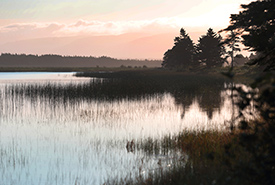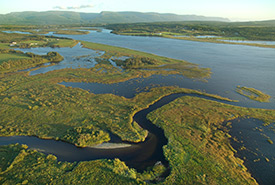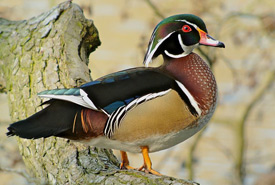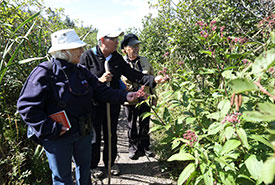A place that’s for the birds: Newfoundland and Labrador’s Codroy Valley is a haven for wildlife and a boon for bird lovers

Grand Codroy Estuary, NL at sunset (Photo by Mike Dembeck)
The saying “for the birds” is often used to state that something or somewhere has little worth or none at all. But when Claudelle Devoe says that the Grand Codroy Estuary in friendly Newfoundland and Labrador is for the birds, she means that to her this area is priceless.
“Newfoundland is known for its hospitality, the fresh air and the beauty of its nature,” she says. “The Grand Codroy Estuary is very unique, with its rich, lush green valley and untouched wetlands, which are home to many important migratory birds in the spring and fall.”
More than 70 species of birds have been identified in this area. Many migratory birds, such as Canada goose and many raptor species, make their way to the Codroy Valley during migration.
A valley bursting with bird calls

Codroy River Estuary, NL (Photo by Mike Dembeck)
These species are a happy sight for Claudelle, who, like these birds species, lives on the estuary.
“My home overlooks the estuary on the Grand Codroy River,” she says. “I can see many species of waterfowl, bald eagles and songbirds that often perch in the trees next to my house.”
The Codroy Valley is a hot spot for birders who want to get up close with the many songbirds, whose chirps often fill the air around the estuary and around Claudelle’s house.
“My favourite species is the white-throated sparrow, because of the beautiful, bright yellow feathers above its eyes,” says Claudelle. “I know when it’s close by because its call sounds like ‘Oh-sweet-Canada.’”
Related content
An important bird area

Wood duck (Photo by Frank Vassen/Wikimedia Commons)
More than 19 species of waterfowl have been sighted in the estuary, including the rare wood duck. In addition, the Grand Codroy Estuary is considered the provincial stronghold for breeding blue-winged teal and American widgeon.
“The Grand Codroy Estuary is the only wetland in Newfoundland and Labrador that is recognized internationally as an Important Wetland under the Ramsar Convention,” says Claudelle. The estuary has two Important Bird Areas and a diversity of birds found nowhere else in the province.
As the chair of the Codroy Valley Area Development Association, Claudelle helps maintain the Wetland Interpretation Centre in the Codroy Valley. The centre offers an opportunity for visitors and students to discover the history of the land and the species that live here.
“The Grand Codroy Estuary is very unique, with its rich, lush green valley and untouched wetlands, which are home to many important migratory birds in the spring and fall.”
“Spending time in nature provides a peaceful feeling of being connected.”
A place to connect with nature

Many visitors take part in activities along the estuary, such as hiking. (Photo by Mike Dembeck)
“Nature education is important, so that we can understand and learn about the habitat of plants and animals that live along the estuary,” reflects Claudelle. “Spending time in nature provides a peaceful feeling of being connected.”
Since 1996, the Nature Conservancy of Canada, with the help of conservation partners such as the Newfoundland and Labrador Department of Municipal Affairs and Environment and Ducks Unlimited Canada, has helped protect more than 600 acres (243 hectares) around the Grand Codroy Estuary.
“Many visitors take part in activities along the estuary, such as hiking and boating along the deeper water areas,” says Claudelle, who believes that by learning about and appreciating the species that reside in the estuary, we are able to connect and grow alongside nature.
“There is room for all of us to co-exist in nature.”


